Battle of the 4 TB NAS Drives: WD Red and Seagate NAS HDD Face-Off
by Ganesh T S on September 4, 2013 6:00 AM EST- Posted in
- NAS
- Seagate
- HDDs
- Western Digital
- Enterprise
Performance - Raw Drives
Prior to evaluating the performance of the drives in a NAS environment, we wanted to check up on the best-case performance of the drives by connecting them directly to a SATA 6 Gbps port. Using HD Tune Pro 5.0, we ran a number of tests on the raw drives. The following screenshots present the results for the various drives in an easy-to-compare manner.
Sequential Reads
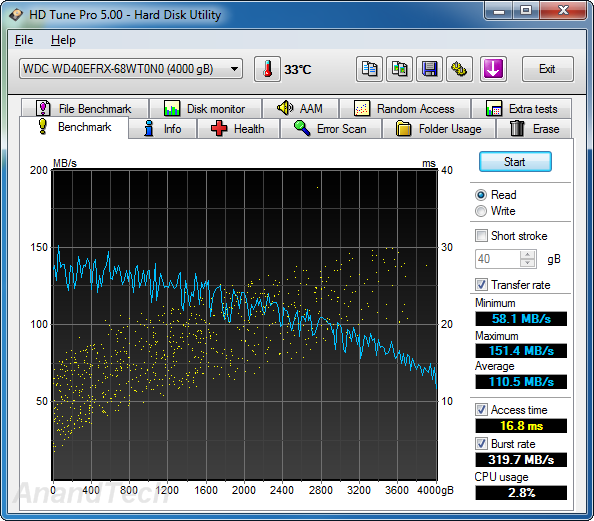
The WD Se and WD Re drives, as expected, lead the benchmark numbers with an average transfer rate of around 136 MBps. The Seagate unit (135 MBps) performs better than the WD Red (111 MBps) in terms of raw data transfer rates, thanks to the higher rotational speed. However, the burst rate of the Seagate NAS HDD is much lower than that of the WD Red. This is probably because the DDR2 memory used in the WD drives is clocked higher than the one in the NAS HDD.
Sequential Writes
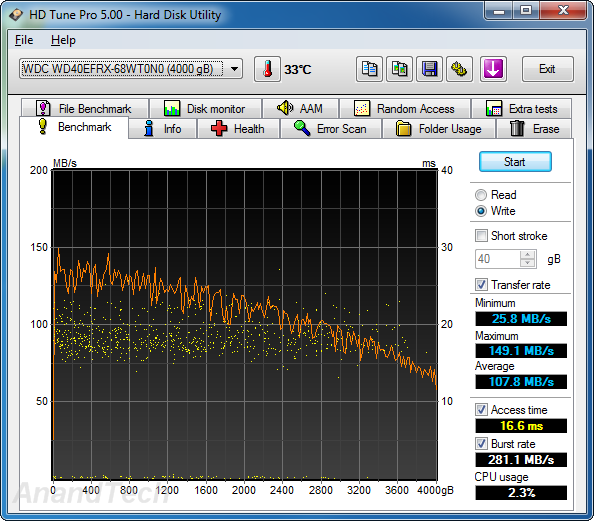
A similar scenario plays out in the sequential write benchmarks. The WD Re leads the pack with an average transfer rate of 135 MBps and the WD Se follows close behind at 133 MBps. The WD Red comes in at 108 MBps and the Seagate NAS HDD clocks in at 131 MBps. The on-board cache in the WD series is faster than that on the Seagate unit, leading to better burst rates.
Random Reads
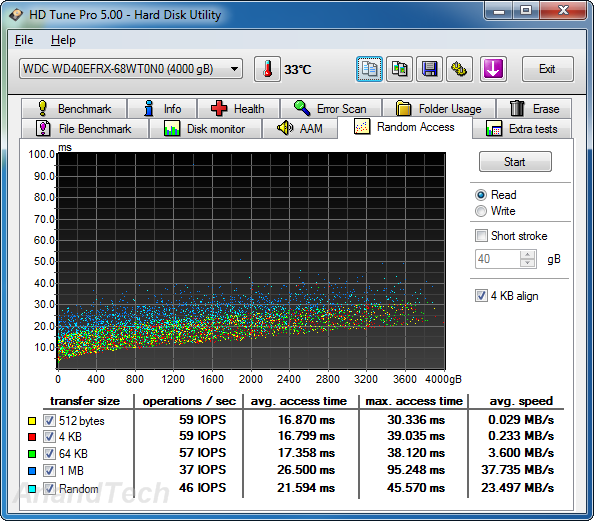
In the random read benchmarks, the WD Red and Seagate NAS HDD perform fairly similar to each other in terms of IOPS as well as average access time. The WD Re edges out the WD Se despite similar rotational speeds and platter structure.
Random Writes

The differences between the enterprise-class drives and the consumer / SOHO NAS drives is even more pronounced in the random write benchmark numbers. The Seagate NAS HDD loses out in terms of both IOPS and average access time to the WD Red. WD Re and WD Se perform much better in this scenario.
Miscellaneous Reads
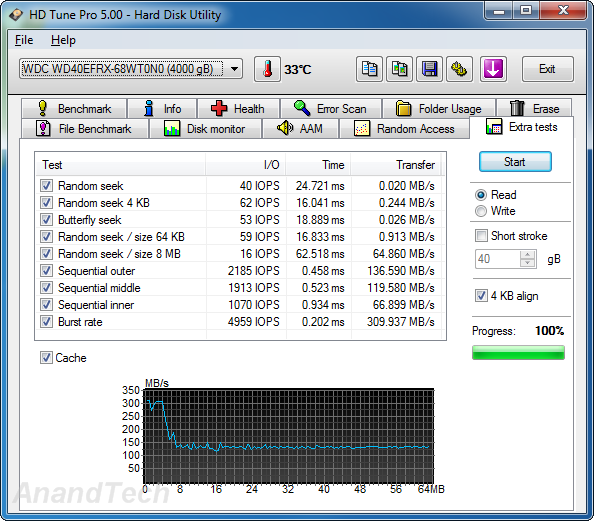
HD Tune Pro also includes a suite of miscellaneous tests such as random seeks and sequential accesses in different segments of the hard disk platters. The numbers above show the WD Red and Seagate NAS HDD matched much more evenly with the NAS HDD emerging slightly better in quite a few of the tests. The cache effects are also visible in the final graph.
Miscellaneous Writes
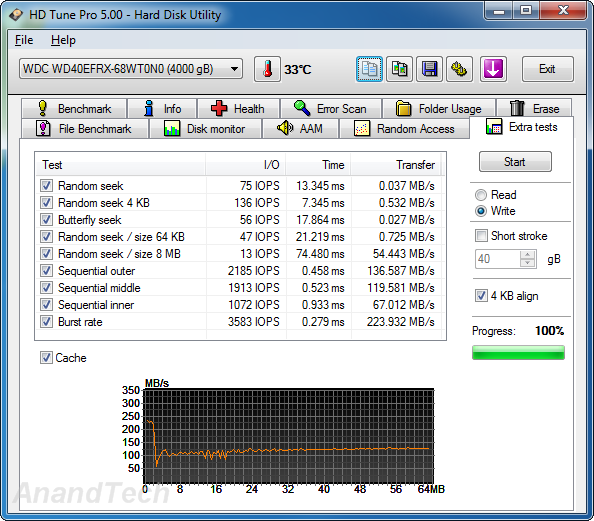
Similar to the previous sub-section, we find that the WD Red edges out the Seagate NAS HDD in the 4KB random seek test, but loses out in a majority of the other tests which are heavily influenced by the rotational speed.
We now have an idea of the standalone performance of the four drives being considered today. In the next section, we will take a look at the performance of these drives when placed inside a typical SOHO / consumer NAS.










54 Comments
View All Comments
Gigaplex - Wednesday, September 25, 2013 - link
Avoid Storage Spaces from Windows. It's an unproven and slow "re-imagination" of RAID as Microsoft likes to call it. The main selling point is flexibility of adding more drives, but that feature doesn't work as advertised because it doesn't rebalance. If you avoid adding more drives over time it has no benefits over conventional RAID, is far slower, and has had far less real world testing on it.Bob Todd - Monday, September 9, 2013 - link
For home use I've gone from RAID 5 to pooling + snapshot parity (DriveBender and SnapRAID respectively). It's still one big ass pool so it's easy to manage, I can survive two disks failing simultaneously with no data loss, and even in the event of a disaster where 3+ fail simultaneously I'll only lose whatever data was on the individual disks that croaked. Storage Spaces was nice in theory, but the write speed for the parity spaces is _horrendous_, and it's still striped so I'd risk losing everything (not to mention expansion in multiples of your column size is a bitch for home use).coolviper777 - Tuesday, October 1, 2013 - link
If you have a good hardware raid card, with BBU and memory, and decent drives, then I think Raid 5 works just fine for home use.I currently have a Raid 5 array using a 3Ware 9560SE Raid card, consisting of 4 x 1.5TB WD Black drives. This card has battery backup and onboard memory. My RAID 5 array works beautifully for my home use. I ran into an issue with a drive going bad. I was able to get a replacement, and the rebuild worked well. There's an automatic volume scan once a week, and I've seen it fix a few error quite a while ago. But nothing very recent.
I get tremendous speed out of my Raid5, and even boot my Windows7 OS from a partition on the Raid 5. Probably, eventually move that to a SSD, but they're still expensive for the size I need for the C: drive.
My biggest problem with Raid1 is that it's hugely wasteful in terms of disk space, and it can be slower than just a single drive. I can understand for mission critical stuff, Raid5 might give issues. However, for home use, if you combine true hardware Raid5 with backup of important files, I think it's a great solution in terms of reliability and performance.
tjoynt - Wednesday, September 4, 2013 - link
++ this. At work we *always* use raid-6: nowadays single drive redundancy is a disaster just waiting to happen.brshoemak - Wednesday, September 4, 2013 - link
"First off, error checking should in general be done by the RAID system, not by the drive electronic."The "should in general" port is where the crux of the issue lies. A RAID controller SHOULD takeover the error-correcting functions if the drive itself is having a problem - but it doesn't do it exclusively, it lets the drives have a first go at it. A non-ERC/TLER/CCTL drive will keep working on the problem for too long and not pass the reigns to the RAID controller as it should.
Also, RAID1 is the most basic RAID level in terms of complexity and I wouldn't have any qualms about running consumer drives in a consumer setting - as long as I had backups. But deal with any RAID level beyond RAID1 (RAID10/6), especially those that require parity data, and you could be in for a world of hurt if you use consumer drives.
Egg - Wednesday, September 4, 2013 - link
No. Hard drives have, for a very very long time, included their own error checking and correcting codes, to deal with small errors. Ever heard of bad blocks?RAID 1 exists to deal more with catastrophic failures of entire drives.
tjoynt - Wednesday, September 4, 2013 - link
RAID systems can't do error checking at that level because they don't have access to it: only the drive electronics do.The problems with recovering RAID arrays don't usually show up with RAID-1 arrays, but with RAID-5 arrays, because you have a LOT more drives to read.
I swore off consumer level raid-5 when my personal raid-5 (on an Intel Matrix RAID-5 :P) dropped two drives and refused to rebuild with them even though they were still perfectly functional.
Rick83 - Thursday, September 5, 2013 - link
Just fix it by hand - it's not that difficult. Of course, with pseudo hardware RAID, you're buggered, as getting the required access to the disk, and forcing partial rebuilds isn't easily possible.I've had a second disk drop out on me once, and I don't recall how exactly I ended up fixing it, but it was definitely possible. I probably just let the drive "repair" the unreadable sectors by writing 512 rubbish bytes to the relevant locations, and tanked the loss of those few bytes, then rebuilt to the redundancy disk.
So yeah, there probably was some data loss, but bad sectors aren't the end of the world.
And by using surface scans you can make the RAID drop drives with bad sectors at the first sign of an issue, then resync and be done with it. 3-6 drive RAID 5 is perfectly okay, if you only have intermediate availability requirements. For high availability RAID 6/RAID 10 arrays with 6-12 disks are a better choice.
mooninite - Thursday, September 5, 2013 - link
Intel chipsets do not offer hardware RAID. The RAID you see is purely software. The Intel BIOS just formats your hard drive with Intel's IMSM (Intel Matrix Storage Manager) format. The operating system has to interpret the format and do all the RAID parity/stripe calculations. Consider it like a file system.Calling Intel's RAID "hardware" or "pseudo-hardware" is a misconception I'd like to see die. :)
mcfaul - Tuesday, September 10, 2013 - link
"First off, error checking should in general be done by the RAID system, not by the drive electronic. "You need to keep in mind how drives work. they are split into 512b/4k sectors... and each sector has a significant chunk of ECC at the end of the sector, so all drives are continually doing both error checking and error recovery on every single read they do.
plus, if it is possible to quickly recover an error, then obviously it is advantageous for the drive to do this, as there may not be a second copy of the data available (i.e. when rebuilding a RAID 1 or RAID 5 array)